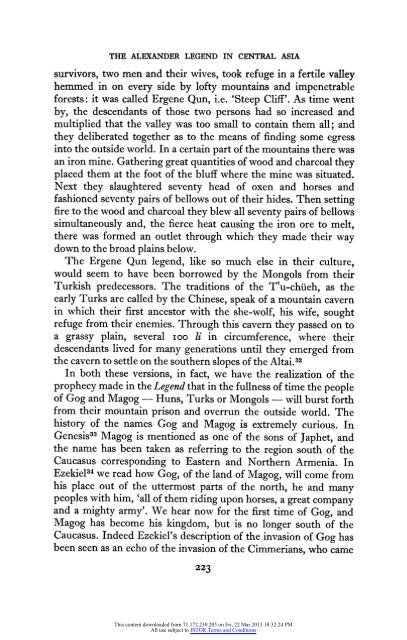The Alexander Legend in Central Asia
The Alexander Legend in Central Asia
The Alexander Legend in Central Asia
Create successful ePaper yourself
Turn your PDF publications into a flip-book with our unique Google optimized e-Paper software.
THE ALEXANDER LEGEND IN CENTRAL ASIA<br />
survivors, two men and their wives, took refuge <strong>in</strong> a fertile valley<br />
hemmed <strong>in</strong> on every side by lofty mounta<strong>in</strong>s and impenetrable<br />
forests: it was called Ergene Qun, i.e. 'Steep Cliff'. As time went<br />
by, the descendants of those two persons had so <strong>in</strong>creased and<br />
multiplied that the valley was too small to conta<strong>in</strong> them all; and<br />
they deliberated together as to the means of f<strong>in</strong>d<strong>in</strong>g some egress<br />
<strong>in</strong>to the outside world. In a certa<strong>in</strong> part of the mounta<strong>in</strong>s there was<br />
an iron m<strong>in</strong>e. Gather<strong>in</strong>g great quantities of wood and charcoal they<br />
placed them at the foot of the bluff where the m<strong>in</strong>e was situated.<br />
Next they slaughtered seventy head of oxen and horses and<br />
fashioned seventy pairs of bellows out of their hides. <strong>The</strong>n sett<strong>in</strong>g<br />
fire to the wood and charcoal they blew all seventy pairs of bellows<br />
simultaneously and, the fierce heat caus<strong>in</strong>g the iron ore to melt,<br />
there was formed an outlet through which they made their way<br />
down to the broad pla<strong>in</strong>s below.<br />
<strong>The</strong> Ergene Qun legend, like so much else <strong>in</strong> their culture,<br />
would seem to have been borrowed by the Mongols from their<br />
Turkish predecessors. <strong>The</strong> traditions of the T'u-chiieh, as the<br />
early Turks are called by the Ch<strong>in</strong>ese, speak of a mounta<strong>in</strong> cavern<br />
<strong>in</strong> which their first ancestor with the she-wolf, his wife, sought<br />
refuge from their enemies. Through this cavern they passed on to<br />
a grassy pla<strong>in</strong>, several Ioo ii <strong>in</strong> circumference, where their<br />
descendants lived for many generations until they emerged from<br />
the cavern to settle on the southern slopes of the Altai.32<br />
In both these versions, <strong>in</strong> fact, we have the realization of the<br />
prophecy made <strong>in</strong> the <strong>Legend</strong> that <strong>in</strong> the fullness of time the people<br />
of Gog and Magog - Huns, Turks or Mongols<br />
- will burst forth<br />
from their mounta<strong>in</strong> prison and overrun the outside world. <strong>The</strong><br />
history of the names Gog and Magog is extremely curious. In<br />
Genesis33 Magog is mentioned as one of the sons of Japhet, and<br />
the name has been taken as referr<strong>in</strong>g to the region south of the<br />
Caucasus correspond<strong>in</strong>g to Eastern and Northern Armenia. In<br />
Ezekiel34 we read how Gog, of the land of Magog, will come from<br />
his place out of the uttermost parts of the north, he and many<br />
peoples with him, 'all of them rid<strong>in</strong>g upon horses, a great company<br />
and a mighty army'. We hear now for the first time of Gog, and<br />
Magog has become his k<strong>in</strong>gdom, but is no longer south of the<br />
Caucasus. Indeed Ezekiel's description of the <strong>in</strong>vasion of Gog has<br />
been seen as an echo of the <strong>in</strong>vasion of the Cimmerians, who came<br />
223<br />
This content downloaded from 71.172.230.205 on Fri, 22 Mar 2013 18:32:24 PM<br />
All use subject to JSTOR Terms and Conditions
















